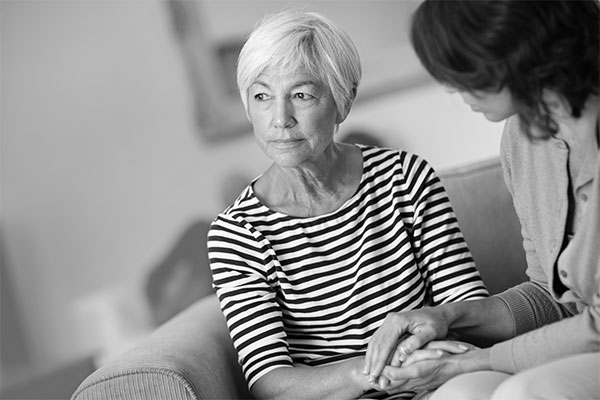Borderline Personality Disorder

Borderline personality disorder (BPD) is a serious mental disorder marked by a pattern of ongoing instability in moods, behavior, self-image, and functioning. These experiences often result in impulsive actions and unstable relationships. A person with BPD may experience intense episodes of anger, depression, and anxiety that may last from only a few hours to days.
Some people with BPD also have high rates of co-occurring mental disorders, such as mood disorders, anxiety disorders, and eating disorders, along with substance abuse, self-harm, suicidal thinking and behaviors, and suicide.
While mental health experts now generally agree that the label "borderline personality disorder" is very misleading, a more accurate term does not exist yet.
Signs and Symptoms
People with BPD may experience extreme mood swings and can display uncertainty about who they are. As a result, their interests and values can change rapidly. Other symptoms include:
- Frantic efforts to avoid real or imagined abandonment
- A pattern of intense and unstable relationships with family, friends, and loved ones, often swinging from extreme closeness and love (idealization) to extreme dislike or anger (devaluation)
- Distorted and unstable self-image or sense of self
- Impulsive and often dangerous behaviors, such as spending sprees, unsafe sex, substance abuse, reckless driving, and binge eating
- Recurring suicidal behaviors or threats or self-harming behavior, such as cutting
- Intense and highly changeable moods, with each episode lasting from a few hours to a few days
- Chronic feelings of emptiness
- Inappropriate, intense anger or problems controlling anger
- Having stress-related paranoid thoughts
- Having severe dissociative symptoms, such as feeling cut off from oneself, observing oneself from outside the body, or losing touch with reality
Seemingly ordinary events may trigger symptoms. For example, people with BPD may feel angry and distressed over minor separations—such as vacations, business trips, or sudden changes of plans—from people to whom they feel close. Studies show that people with this disorder may see anger in an emotionally neutral face and have a stronger reaction to words with negative meanings than people who do not have the disorder.
Some of these signs and symptoms may be experienced by people with other mental health problems—and even by people without mental illness—and do not necessarily mean that they have BPD. It is important that a qualified and licensed mental health professional conduct a thorough assessment to determine whether or not a diagnosis of BPD or other mental disorder is warranted, and to help guide treatment options when appropriate.
Tests and Diagnosis
Unfortunately, BPD is often underdiagnosed or misdiagnosed. A licensed mental health professional experienced in diagnosing and treating mental disorders—such as a psychiatrist, psychologist, or clinical social worker—can diagnose BPD based on a thorough interview and a comprehensive medical exam, which can help rule out other possible causes of symptoms.
The licensed mental health professional may ask about symptoms and personal and family medical histories, including any history of mental illnesses. This information can help the mental health professional decide on the best treatment. In some cases, co-occurring mental illnesses may have symptoms that overlap with BPD, making it difficult to distinguish BPD from other mental illnesses. For example, a person may describe feelings of depression but may not bring other symptoms to the mental health professional's attention.
Research funded by NIMH is underway to look for ways to improve diagnosis of and treatments for BPD, and to understand the various components of BPD and other personality disorders such as impulsivity, relationship problems, and emotional instability.
Risk Factors
The causes of BPD are not yet clear, but research suggests that genetic, brain, environmental and social factors are likely to be involved.
- Genetics - BPD is about five times more likely to occur if a person has a close family member (first-degree biological relatives) with the disorder.
- Environmental and Social Factors - Many people with BPD report experiencing traumatic life events, such as abuse or abandonment during childhood. Others may have been exposed to unstable relationships and hostile conflicts. However, some people with BPD do not have a history of trauma. And, many people with a history of traumatic life events do not have BPD.
- Brain Factors - Studies show that people with BPD have structural and functional changes in the brain, especially in the areas that control impulses and emotional regulation. However, some people with similar changes in the brain do not have BPD. More research is needed to understand the relationship between brain structure and function and BPD.
Research on BPD is focused on examining biological and environmental risk factors, with special attention on whether early symptoms may emerge at a younger age than previously thought. Scientists are also studying ways to identify the disorder earlier in adolescents.
Treatments and Therapies
BPD has historically been viewed as difficult to treat. However, with newer and proper treatment, many people with BPD experience fewer or less severe symptoms and an improved quality of life. Many factors affect the length of time it takes for symptoms to improve once treatment begins, so it is important for people with BPD and their loved ones to be patient and to receive appropriate support during treatment. People with BPD can recover.
If you think you have BPD, it is important to seek treatment.
National Institute of Mental Health-funded (NIMH) studies indicate that BPD patients who never recovered may be more likely to develop other chronic medical conditions and are less likely to make healthy lifestyle choices. BPD is also associated with a high rate of self-harm and suicidal behavior.
If you are thinking about harming yourself or attempting suicide, tell someone who can help right away. Call your licensed mental health professional if you are already working with one. If you are not already working with a licensed mental health professional, call your personal physician or go to the nearest hospital emergency room.
If a loved one is considering suicide, do not leave him or her alone. Try to get your loved one to seek immediate help from his or her doctor or the nearest hospital emergency room, or call 911. Remove any access he or she may have to firearms or other potential tools for suicide, including medications, sharp edges such as knives, ropes, or belts.
If you or a loved one are in crisis, call the national Suicide & Crisis Lifeline at 988, available 24 hours a day, 7 days a week. The service is available to anyone. All calls are confidential.
The treatments described below are just some of the options that may be available to a person with BPD. However, the research on treatments is still in very early stages. More research is needed to determine the effectiveness of these treatments, who may benefit the most, and how best to deliver treatments.
Psychotherapy
Psychotherapy (or “talk therapy”) is the main treatment for people with BPD . Current research suggests psychotherapy can relieve some symptoms, but further studies are needed to better understand how well psychotherapy works. Psychotherapy can be provided one-on-one between the therapist and the patient or in a group setting. Therapist-led group sessions may help teach people with BPD how to interact with others and how to express themselves effectively. It is important that people in therapy get along with and trust their therapist. The very nature of BPD can make it difficult for people with this disorder to maintain a comfortable and trusting bond with their therapist. Types of psychotherapy used to treat BPD include:
- Cognitive Behavioral Therapy (CBT) - CBT can help people with BPD identify and change core beliefs and/or behaviors that underlie inaccurate perceptions of themselves and others and problems interacting with others. CBT may help reduce a range of mood and anxiety symptoms and reduce the number of suicidal or self-harming behaviors.
- Dialectical Behavior Therapy (DBT) - This type of therapy utilizes the concept of mindfulness, or being aware of and attentive to the current situation and moods. DBT also teaches skills to control intense emotions, reduce self-destructive behaviors, and improve relationships. DBT differs from CBT in that it integrates traditional CBT elements with mindfulness, acceptance, and techniques to improve a person’s ability to tolerate stress and control his or her emotions. DBT recognizes the dialectical tension between the need for acceptance and the need for change.
- Schema-Focused Therapy - This type of therapy combines elements of CBT with other forms of psychotherapy that focus on reframing schemas, or the ways people view themselves. This approach is based on the idea that BPD stems from a dysfunctional self-image—possibly brought on by negative childhood experiences—that affects how people react to their environment, interact with others, and cope with problems or stress.
- Systems Training for Emotional Predictability and Problem Solving (STEPPS) - This is a type of group therapy that aims to educate family members, significant others, and health care professionals about BPD and gives them guidance on how to interact consistently with the person with the disorder using the STEPPS approach and terminology. STEPPS is designed to supplement other treatments the patient may be receiving, such as medication or individual psychotherapy.
Families of people with BPD may also benefit from therapy. The challenges of dealing with a loved one with BPD on a daily basis can be very stressful, and family members may unknowingly act in ways that worsen their relative's symptoms. Some therapies include family members in treatment sessions. These types of programs help families develop skills to better understand and support a relative with BPD. Other therapies focus on the needs of family members and help them understand the obstacles and strategies for caring for a loved one with BPD. Although more research is needed to determine the effectiveness of family therapy in BPD, studies on other mental disorders suggest that including family members can help in a person's treatment.
Other types of psychotherapy may be helpful for some people with BPD. Therapists often adapt psychotherapy to better meet a person's needs. Therapists may also switch from one type of psychotherapy to another, mix techniques from different therapies, or use a combination of psychotherapies. For more information, please see the NIMH webpage on Psychotherapies.
Medications
Medications should not be used as the primary treatment for BPD as the benefits are unclear. However, in some cases, a mental health professional may recommend medications to treat specific symptoms, such as mood swings, depression, or other disorders that may occur with BPD. Treatment with medications may require care from more than one medical professional.
Because of the high risk of suicide among people with BPD, health care providers should exercise caution when prescribing medications that may be lethal in the event of an overdose.
Certain medications can cause different side effects in different people. Talk to your doctor about what to expect from a particular medication.
Other Treatments
Some people with BPD experience severe symptoms and require intensive, often inpatient, care. Others may use some outpatient treatments but never need hospitalization or emergency care. Although in rare cases, some people who develop this disorder may improve without any treatment, most people benefit from and improve their quality of life by seeking treatment.
How can I help a friend or relative who has BPD?
If you know someone who has BPD, it affects you too. The first and most important thing you can do is help your friend or relative get the right diagnosis and treatment. You may need to make an appointment and go with your friend or relative to see the doctor. Encourage him or her to stay in treatment or to seek different treatment if symptoms do not appear to improve with the current treatment. To help a friend or relative you can:
- Offer emotional support, understanding, patience, and encouragement—change can be difficult and frightening to people with BPD, but it is possible for them to get better over time.
- Learn about mental disorders, including BPD, so you can understand what your friend or relative is experiencing.
- With written permission from your friend or loved one, talk with his or her therapist to learn about therapies that may involve family members. Alternatively, you can encourage your loved one who is in treatment for BPD to ask about family therapy.
- Seek counseling from your own therapist about helping a loved one with BPD. It should not be the same therapist that your loved one with BPD is seeing.
Never ignore comments about someone's intent or plan to harm himself or herself or someone else. Report such comments to the person's therapist or doctor. In urgent or potentially life-threatening situations, you may need to call the police or dial 911.
How can I help myself if I have BPD?
Although it may take some time, you can get better with treatment. To help yourself:
- Talk to your doctor about treatment options and stick with treatment.
- Try to maintain a stable schedule of meals and sleep times.
- Engage in mild activity or exercise to help reduce stress.
- Set realistic goals for yourself.
- Break up large tasks into small ones, set some priorities, and do what you can, as you can.
- Try to spend time with other people and confide in a trusted friend or family member.
- Tell others about events or situations that may trigger symptoms.
- Expect your symptoms to improve gradually over time, not immediately. Be patient.
- Identify and seek out comforting situations, places, and people.
- Continue to educate yourself about this disorder.
- Don’t drink alcohol or use illicit drugs – they will likely make things worse
This article is in the public domain and reprinted here with permission by the National Institute of Mental Health.






















